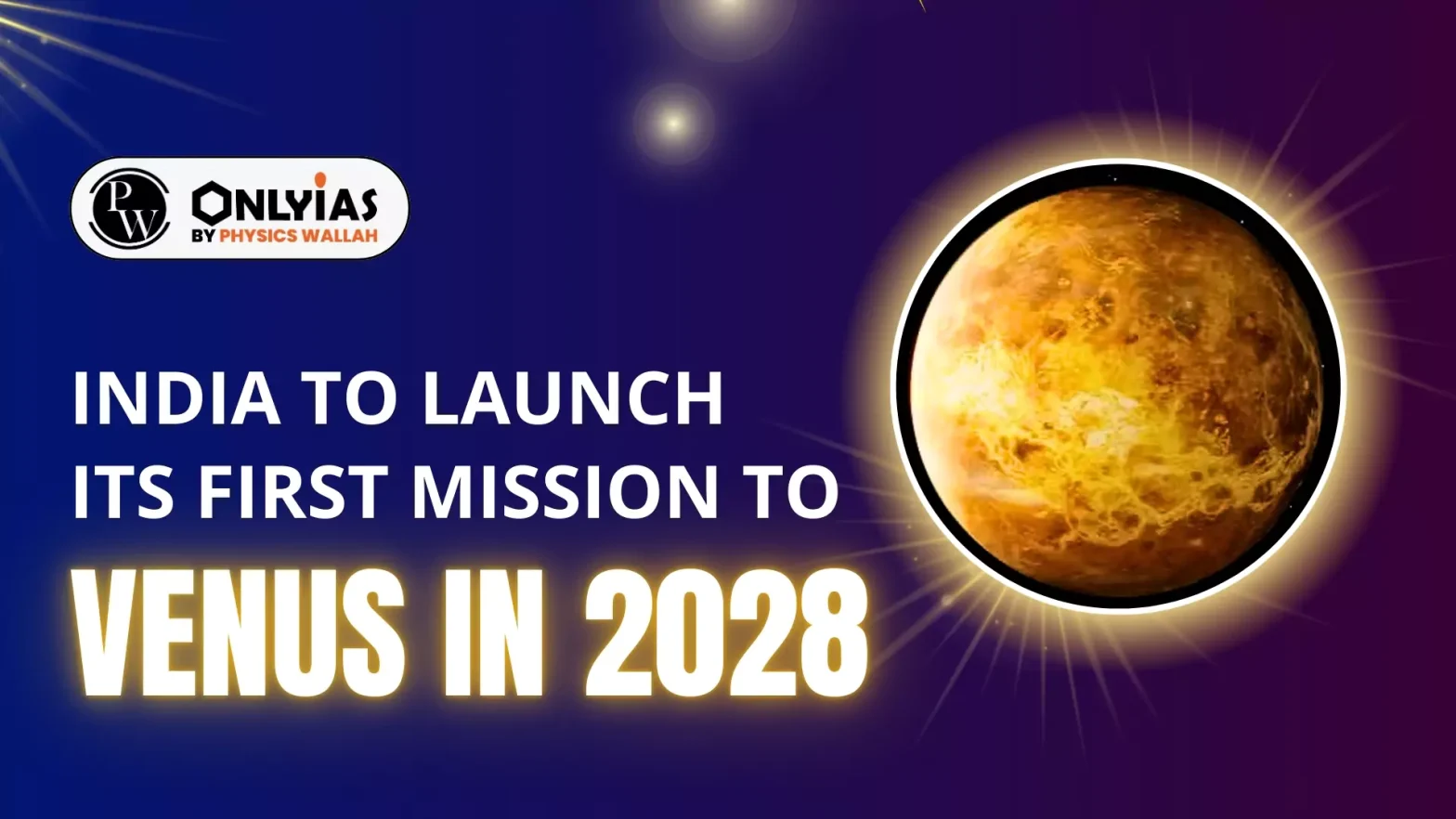The Union Cabinet recently approved India’s first mission to Venus, which ISRO plans to launch in March 2028, marking the country’s second interplanetary mission after the Mars Orbiter Mission in 2013. This mission aims to study Venus from orbit, utilizing scientific instruments from India and abroad to examine the planet’s surface, sub-surface, atmosphere, ionosphere, and its interaction with the Sun.
Basics: Similarities and Differences Between Venus and Earth
- Earth’s Twin: Venus is often referred to as Earth’s twin planet due to its similarities in mass, density, and size. These characteristics make Venus a valuable target for scientific study, as insights gained from understanding Venus may shed light on Earth’s evolutionary history.
- Significant Differences: Despite these similarities, Venus diverges from Earth in crucial ways. Notably, Venus has an extremely high surface temperature, averaging around 462 degrees Celsius, which is even hotter than Mercury, the planet closest to the Sun. This extreme heat is largely attributed to a runaway greenhouse effect, where thick clouds of carbon dioxide trap heat in the atmosphere, leading to the planet’s inhospitable conditions.
- Water Evaporation: It is believed that the water present on Venus’s surface evaporated due to its proximity to the Sun. As water vapour is a greenhouse gas, it contributes to an increasing greenhouse effect, trapping more heat and leading to further evaporation of any remaining water. This process transformed Venus into a dry and dusty planet. Notably, no lander has survived on Venus for more than a couple of hours due to these extreme conditions; for example, the Soviet Union’s Venera series of spacecraft struggled to withstand the harsh environment.
- Atmospheric Pressure: The atmospheric pressure on Venus is significantly higher than that on Earth, comparable to the pressure experienced at the depths of Earth’s oceans. This immense pressure makes the environment hostile for human exploration.
- Composition of the Atmosphere: Venus’s atmosphere consists of approximately 96.5% carbon dioxide, with thick clouds of sulfuric acid. This makes the atmosphere suffocating and inhospitable for humans.
- Slow Rotation: Venus has an exceptionally slow rotation on its axis compared to Earth. A single rotation of Venus takes about 243 Earth days.
Enroll now for UPSC Online Course
Venus Mission Overview
- Launch Timing: The mission to Venus is planned for a time when Earth and Venus are in close proximity, which occurs every 19 months. This alignment offers the shortest path for the mission. Initially scheduled for 2023, recent cabinet approvals have pushed the launch date to March 2028.
- Objectives of the Mission: ISRO (Indian Space Research Organisation) aims to study Venus’s atmosphere, surface, and subsurface features. This research is significant for comparing Earth and Venus, which will help scientists understand how Earth might evolve in the future.
- Features
- The mission will carry scientific payloads weighing approximately 100 kg. These instruments will be designed to gather valuable data about Venus.
- The mission will follow a strategy similar to India’s other space exploration initiatives. It will first launch into Earth’s orbit, where the satellite will gain speed. This will involve a “sling-shot” manoeuvre, using Earth’s gravity to propel the spacecraft toward Venus. Once the satellite exits Earth’s orbit, it is expected to take around 140 days to reach Venus. This mission will also mark India’s first attempt at aero-braking, a technique where a spacecraft uses the atmosphere of a planet to slow down and adjust its orbit.
Sling-shot Manoeuvre
A sling-shot manoeuvre, also known as a gravitational assist, is a technique used in spaceflight where a spacecraft uses the gravitational pull of a planet to gain speed and alter its trajectory. This method helps conserve fuel and allows for more efficient travel between planets.
Aero-Braking
- Fuel Efficiency Considerations: To optimise fuel use, the satellite will initially be placed in a highly elliptical orbit around Venus, with dimensions of 500 km x 60,000 km. However, this altitude is too high for the scientific payloads to conduct effective experiments, as the equipment may not function properly at such elevations.
- Adjusting the Orbit: To facilitate experiments, the satellite’s orbit will be adjusted to either 300 km x 300 km or 200 km x 600 km, depending on the finalised requirements of the payload. This adjustment will be achieved through the process of aero-braking.
- Mechanism of Aero-Braking: Aero-braking involves the satellite descending into the upper atmosphere of Venus at its closest point in the elliptical orbit. This will push the satellite down to around 140 km multiple times. By using the planet’s upper atmosphere to reduce speed, the satellite conserves fuel, as it does not rely on thrusters to achieve this manoeuvre.
- Risks Involved: While aero-braking is a fuel-efficient method, it carries risks. The satellite must carefully manage how deeply it descends into the upper atmosphere to avoid overheating or burning up due to atmospheric friction. The optimal depth must be maintained to ensure the satellite remains intact while effectively slowing down.
In simple words, in this process, fuel is not used; instead, the planet’s upper atmosphere is utilised to reduce the spacecraft’s speed. However, this method is risky because the spacecraft might burn up if it descends too deeply into the atmosphere. Therefore, it is crucial to carefully maintain the optimal depth in the upper atmosphere. |
Scientific Payloads for the Venus Mission
The upcoming Venus mission will carry a range of scientific payloads, aimed at enhancing our understanding of the planet. Proposals for at least 17 Indian experiments and seven international ones were selected by 2019, as reported in a parliamentary response. Key Indian payloads include:
- Synthetic Aperture Radar: Operating in L and S bands, this radar will assist in imaging the surface of Venus, providing crucial data on its geological features.
- Thermal Camera: This instrument will help analyse the temperature variations on the Venusian surface and atmosphere.
- Interplanetary Dust Study: An experiment designed to investigate the flow of interplanetary dust particles, contributing to our understanding of space weathering effects on Venus.
- High-Energy Particle Experiment: This payload will study the high-energy particles entering the Venusian atmosphere, which can lead to ionisation and provide insights into atmospheric dynamics.
- Atmospheric Composition and Structure Study: This experiment aims to examine the composition, structure, variability, and thermal state of Venus’s atmosphere, contributing to our understanding of its climate and weather patterns.
Check Out UPSC Modules From PW Store
Conclusion
The upcoming Venus mission represents a significant step in India’s space exploration efforts, aiming to unlock the mysteries of our neighbouring planet. By enhancing our understanding of Venus’s atmosphere, geology, and potential similarities to Earth, this mission may provide valuable insights into planetary evolution and the broader dynamics of our solar system.
![]() 24 Sep 2024
24 Sep 2024

